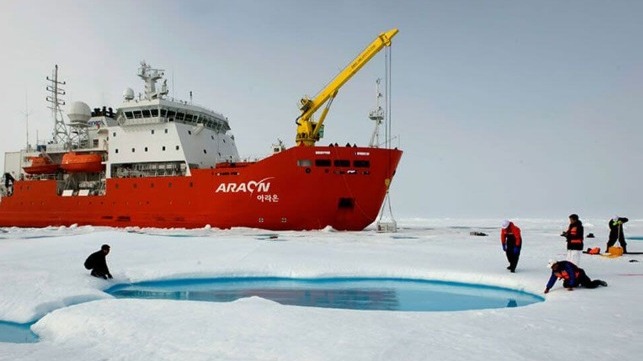South Korea Plans to Order a New $200M Icebreaker

South Korea intends to invest $205 million in building a new icebreaking research vessel as part of plans to strengthen high-latitude research. The vessel could help support the establishment of the world’s sixth research station in inland Antarctica by 2030.
The Ministry of Oceans and Fisheries said that the cabinet has approved a $205 million budget for the construction of a 15,000 tonne-class icebreaking research vessel by 2026, which is expected to help the country lead joint projects in exploring the North Pole. The next-generation icebreaker will have the capacity to break 1.5-meter-thick ice at a speed of three knots, enabling it to advance to the high Arctic Ocean.
The new icebreaker will replace the RV Araon, a 6,950-tonne icebreaker commissioned in 2009 and designed for operation in one-meter-thick-multiple-year ice conditions only. The $100 million ship was the first icebreaking vessel built in South Korea.
In December 2011, the Araon - whose main missions have been supplying South Korea’s two Antarctic bases and carrying out polar research - gained worldwide fame after successfully undertaking a rescue operation involving Russian trawler Sparta, which had been trapped in Antarctic sea ice.
The construction of a new icebreaker forms part of South Korea’s comprehensive ambition to promote polar activities, which will also include construction of an Antarctic inland research station. The program will enable high-latitude economic activity, international cooperation, manpower training and scientific research covering the South and North Poles.
“We will implement the basic plans to seek a solution to respond to climate changes and to develop new advanced technologies,” said Cho Seung-hwan, Oceans and Fisheries Minister.
Currently South Korea has two Antarctic research stations, the King Sejong Station built in 1988 on King George Island and the Jang Bogo Station established in 2014 in Terra Nova Bay. The country plans to build the third station beginning with a site selection by 2027.
When completed, the station would be the country's first and the world's sixth inland station in the South Pole. There are five inland Antarctic research bases run by the U.S, Russia, Japan and China, as well as one jointly by France and Italy.
